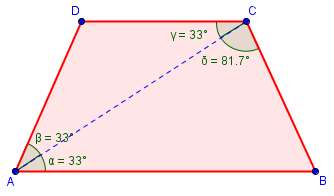You are using an out of date browser. It may not display this or other websites correctly.
You should upgrade or use an alternative browser.
You should upgrade or use an alternative browser.
Bisector in a trapezoid
- Thread starter lev888
- Start date
Dr.Peterson
Elite Member
- Joined
- Nov 12, 2017
- Messages
- 16,121
Clearly not:I am looking at an 8th grade Russian School of Math geometry problem that mentions "an angle bisector AC" in a trapezoid ABCD. My question: since AC divides 2 angles, is it correct to assume that AC bisects both of them?

Or are you asking whether the wording implies that they intend to say that it bisects both angles? If so, we have to ask whether (in that language) "trapezoid" includes "rhombus".
I'd be interested to see the entire problem (in English or Russian) to see the wording in context.
lev888
Elite Member
- Joined
- Jan 16, 2018
- Messages
- 2,940
Thanks. Attaching the problem. RSM has locations in US and Canada, so everything is in EnglishClearly not:
View attachment 30949
Or are you asking whether the wording implies that they intend to say that it bisects both angles? If so, we have to ask whether (in that language) "trapezoid" includes "rhombus".
I'd be interested to see the entire problem (in English or Russian) to see the wording in context.
Attachments
lev888
Elite Member
- Joined
- Jan 16, 2018
- Messages
- 2,940
Don't see why it has to be a rhombus if both angles are bisected.Clearly not:
View attachment 30949
Or are you asking whether the wording implies that they intend to say that it bisects both angles? If so, we have to ask whether (in that language) "trapezoid" includes "rhombus".
I'd be interested to see the entire problem (in English or Russian) to see the wording in context.
Based on the correspondence of vertices of the similar triangles it does look like only one angle is bisected by AC.
Dr.Peterson
Elite Member
- Joined
- Nov 12, 2017
- Messages
- 16,121
There are several issues with the problem:

First, as you point out, it needs to state what angle AC bisects; but also, it ought to say which sides are parallel (assuming they are using the American definition of trapezoid that requires at least two parallel sides -- I forgot to take that into account!).
Is there no picture?
The wording also seems odd to me in that the fact that AC would bisect any angle is special enough to deserve mention first: "If the diagonal AC of trapezoid ABCD bisects angle A, and ...".
I think if AC bisected both angles A and C, it would have to be a rhombus, supposing that AB is parallel to CD, because ABC would have to be isosceles, and ADC would be similar. But clearly it can't be a rhombus, because then triangles ABC and ADC would be similar. At least I think so -- but I'm getting dizzy juggling all the possible interpretations of this!
If I assume that AD and BC are parallel, and angle A is bisected, then it's not hard to solve.

First, as you point out, it needs to state what angle AC bisects; but also, it ought to say which sides are parallel (assuming they are using the American definition of trapezoid that requires at least two parallel sides -- I forgot to take that into account!).
Is there no picture?
The wording also seems odd to me in that the fact that AC would bisect any angle is special enough to deserve mention first: "If the diagonal AC of trapezoid ABCD bisects angle A, and ...".
I think if AC bisected both angles A and C, it would have to be a rhombus, supposing that AB is parallel to CD, because ABC would have to be isosceles, and ADC would be similar. But clearly it can't be a rhombus, because then triangles ABC and ADC would be similar. At least I think so -- but I'm getting dizzy juggling all the possible interpretations of this!
If I assume that AD and BC are parallel, and angle A is bisected, then it's not hard to solve.
lev888
Elite Member
- Joined
- Jan 16, 2018
- Messages
- 2,940
Figured out the rhombus part.Don't see why it has to be a rhombus if both angles are bisected.
Based on the correspondence of vertices of the similar triangles it does look like only one angle is bisected by AC.
lev888
Elite Member
- Joined
- Jan 16, 2018
- Messages
- 2,940
No diagram. I was missing the pair of interior alternate angles that made the triangles isosceles.There are several issues with the problem:
View attachment 30951
First, as you point out, it needs to state what angle AC bisects; but also, it ought to say which sides are parallel (assuming they are using the American definition of trapezoid that requires at least two parallel sides -- I forgot to take that into account!).
Is there no picture?
The wording also seems odd to me in that the fact that AC would bisect any angle is special enough to deserve mention first: "If the diagonal AC of trapezoid ABCD bisects angle A, and ...".
I think if AC bisected both angles A and C, it would have to be a rhombus, supposing that AB is parallel to CD, because ABC would have to be isosceles, and ADC would be similar. But clearly it can't be a rhombus, because then triangles ABC and ADC would be similar. At least I think so -- but I'm getting dizzy juggling all the possible interpretations of this!
If I assume that AD and BC are parallel, and angle A is bisected, then it's not hard to solve.

